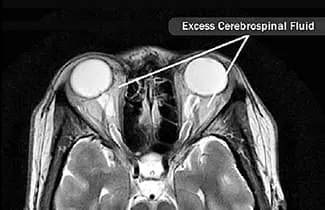Now more commonly called idiopathic intracranial hypertension (IIH), pseudotumor cerebri is a brain condition that causes the same symptoms as a brain tumor: headaches, vision problems, nausea, and dizziness. But it's not a tumor.
"Pseudotumor" means "false tumor." It's caused by increased pressure around the brain.
It can be hard to tell a pseudotumor from a real tumor. So you should see your doctor to have your symptoms checked out. The symptoms of pseudotumor cerebri can get worse and hurt your vision. Getting treated quickly can help save your sight.
Causes
Pseudotumor cerebri can happen if pressure rises around your brain due to too much cerebrospinal fluid. This fluid surrounds your brain and spinal cord and protects them from injury.
Your body constantly makes cerebrospinal fluid. Then it reabsorbs the fluid through your blood vessels to keep the same amount flowing around your brain and spinal cord.

Who’s at Risk
Pseudotumor cerebri is most common in women ages 20 to 50, especially if they are obese.
Other conditions that can raise your risk include:
- Addison's disease
- Anemia
- Behcet's syndrome
- Blood vessel or blood clotting problems
- Lupus
- Lyme disease
- Kidney disease
- Measles
- Polycystic ovary syndrome
- Sleep apnea
- Underactive parathyroid glands
Taking these medicines can also make you more likely to develop pseudotumor cerebri:
- Certain antibiotics
- Birth control pills
- Growth hormone
- Lithium
- Steroids
- Vitamin A-based drugs
Symptoms
Signs you might have this condition include:
- Positional headaches that start behind your eyes or in the back of your head, are worse when lying down and get better when sitting up
- Blurry vision or double vision
- A blackout in your vision that lasts for a few seconds at a time
- Nausea, throwing up
- Dizziness
- Ringing in your ears that pulses in time with your heartbeat
- Stiff neck
Your symptoms might get worse when you exercise. This is because activity boosts the pressure in your brain.
Diagnosis
First, your doctor will ask about your symptoms and medical history.
The biggest clue is when your doctor looks at the optic nerve, using ultrasound or a tool called an ophthalmoscope, and seeing that it’s swollen.
You might get one or more of these tests:
- Spinal tap (lumbar puncture). The doctor inserts a needle into your lower back and removes a small amount of fluid from around your spine. This test can check for increased pressure in your skull and to relieve the pressure to help save vision.
- CT, or computed tomography. It's a powerful X-ray that makes detailed pictures of your brain.
- MRI, or magnetic resonance imaging. It uses powerful magnets and radio waves to show increased pressure or abnormal growths in your brain.
You'll also need regular vision tests. Your eye doctor will check whether you have any blind spots in your vision or swelling of the optic nerve in the back of your eye. These are signs of pseudotumor cerebri.
Treatment
Getting treated as soon as possible can help you keep your vision.
One of the best ways to ease symptoms is to lose extra pounds. It can be hard to do that on your own, so you may want to get help from a dietitian, personal trainer, or weight loss clinic. Also, limit salt and fluids in your diet to lower the amount of spinal fluid your body makes.
Medicine and surgery are the main treatments for pseudotumor cerebri. They reduce the pressure in your skull.
A few medicines are used to treat this condition:
- Acetazolamide (Diamox) is a diuretic as well as a glaucoma drug that lowers the amount of cerebrospinal fluid your body makes.
- Migraine medicines if you get this type of headache.
If your symptoms are severe or they don't get better with medicine, you might need surgery to reduce pressure in your brain or behind your eyes. These procedures are used to treat pseudotumor cerebri:
- Shunting. The surgeon inserts a long, thin tube called a shunt into your brain or spine to drain extra fluid.
- Optic nerve sheath fenestration. The surgeon makes a cut in the tissue around the optic nerve to allow fluid to drain.
What to Expect
With treatment, the pressure in your brain will go down. You should start to feel better within a few months. Most people completely recover, but a few will have permanent vision loss.
Because pseudotumor cerebri can come back, see your doctor for follow-up visits and get regular eye checkups. Tell the doctor right away if you notice any new symptoms.
Lose weight if you're overweight to help prevent pseudotumor cerebri from coming back. If you have a lot of weight to lose and diet and exercise alone don't help enough, your doctor might suggest weight loss surgery.

